How the ancient Slavs fought
In a number of articles that we have planned for publication on "VO", we will focus on weapons and how they were used by the early Slavs. The first article will be devoted to the tactics of the Slavs during the XNUMXth and up to the beginning of the XNUMXth centuries. We will separately consider a question that causes a lot of controversy: did the early Slavs have cavalry?
These works continue the cycle dedicated to the ancient military stories Slavs.
The tactics of the early Slavs of the XNUMXth - early XNUMXth centuries.
The use of one or another weapon during the period under review, the methods of its use reflect the situation in society:
(Golitsyn N.S.)
They stem from the understanding by society of the structure of the world, based on the experience of economic and ordinary life.
Until the period when, within the framework of one or another early social organization, there was no understanding about the possibility of obtaining a surplus product not by productive means, but by means of capture, military "business" was always a continuation of the production capabilities of an ethnic group.
The Slavs, detailed written evidence of which appears only in the XNUMXth century, could not have had any other tactics than the one that dictated to them the conditions of life and work.
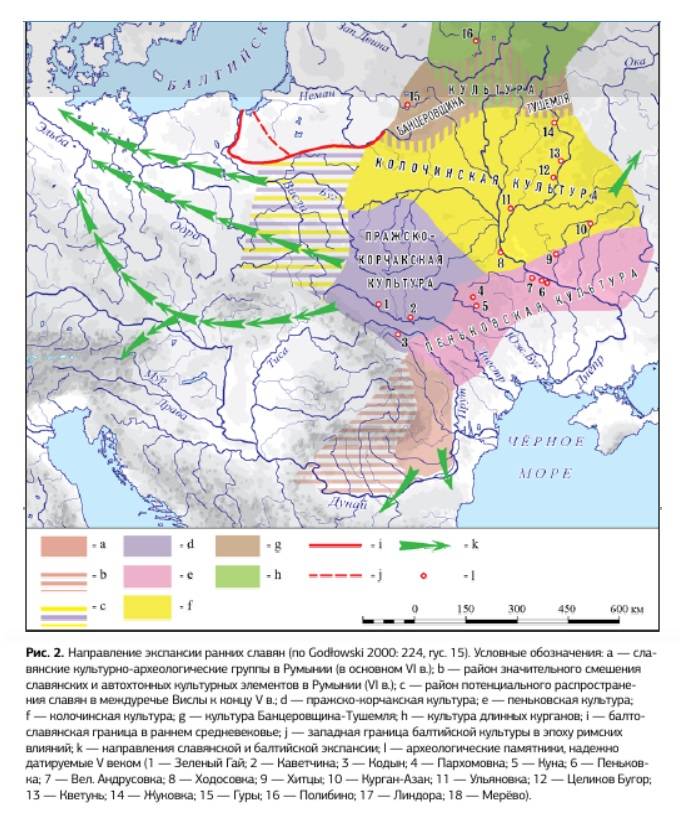
Since their appearance on the historical stage, the raid and ambush have become the main type of military activity:
Most of the information is devoted to the preference of the Slavs to fight in forests, cliffs and gorges.
In intelligence, they had no equal. At the time of a sudden raid on their villages, Slavic soldiers, hiding from enemies, sank under the water and breathed through a long reed, being in this position for several hours.
This is how the Slav-intelligence agent captures the "tongue", about which Procopius wrote to us. It happened in Italy:
The Antes "with their characteristic valor" fought against the Goths, in the troops of Byzantium, "in remote areas."
In 705, in Friula, horsemen and infantry of the Lombards attacked the Slavic raiders who had entrenched themselves on the mountain. The Slavs knocked down the riders with horses with stones and axes, killing all the nobility of Friul, and won the battle.
It is better to convey the ability of the Slavs to disguise than Theophylact Simokatta did, it is impossible:
As a result, the strategist Peter, not believing that there was an ambush, began the crossing and immediately lost a thousand soldiers.
This tactic was used more than once by the Slavs, compensating for their weakness in weapons, even later, in 614:
Constantine V (741-775) in 760 made a raid on Bulgaria, but in the Vyrbish mountain pass he fell into an ambush, which, most likely, was organized by the paktiots of the Bulgarians, the border Slavs. Slavs, for whom the organization of ambushes was a natural thing in the war. The Byzantines were defeated, the strategy of the Thrace was killed.
As for the clashes of the Slavs in open battle, then without a doubt, we can only talk about the battle with the "crowd".
The author of the XNUMXth century wrote about the "crowd" of Slavs. Jordan, who compared them with the tactics of the Goths in the XNUMXth century. He pointed out that only large numbers ensure success for the Slavs: taking advantage of their numerical superiority, the Antes fought the Goths with varying success. And having reached the borders of the Byzantine Empire, the Slavs continued to fight, if, of course, they were forced to do so by the combat situation, "in a crowd" (Ομιλoς). Periodically, from the middle of the VI century. in relation to the Slavic formations, Procopius of Caesarea uses the term "army" (Στράτευμα or Στpατός).
But it is difficult to agree with the conclusions of S.A. Ivanov, who studied these terms in the works of Procopius of Caesarea, that Ομιλoς is a militia, and Στpατός are professional detachments. There is no mention of any professional military groups, that is, people living not within the framework of a tribal organization, but only by war, in the sources. Individual, rare reports about some Slavic warriors and even a separate detachment of antes mentioned by Procopius in service in the Roman empire, which we wrote about in previous articles on "VO", do not change anything.
With traditional mass Slavic weapons (about it in the following articles), there is no need to talk about any use of the correct system. Throwing spears in the absence of otherwise weapons could only be used within the "crowd", and they were extremely dangerous:
In case of failure, the Slavic soldiers simply fled. Therefore, we cannot agree with the reconstruction of the Slavic military action in the XNUMXth century, which, according to the researcher, looked like this:
And further, the first row of Slavs stands with shields, the rest without: with darts and bows (Nefyodkin A.K.).
If such a construction took place, it would obviously be reflected in the sources, but they are silent about such tactics.
Speaking about hand-to-hand combat, we note that indirect data gives us the right to assume that the Slavs quite actively used a technologically simple but effective melee weapon - a club. But about this - in the appropriate place.
The Slavs, as indicated by Mauritius Stratig, preferred to fight from the fortifications, occupying positions on a hill and reliably covering the rear and flanks.
There is evidence of the use of fortifications from carts (Karagon or Wagenburg) by the Slavs.
The period of transition from the tactics of ambushes and raids to the rare use of more correct battle conditions is quite long, I repeat, historical sources also speak of this.
F. Cardini called this period the time of transition "from the mob to the ranks."
We have already written in previous articles on "VO" about the difficulty of studying the period of this transition: "from the mob to the formation."
On the one hand, a comparative historical analysis shows that the boundaries of the transition are complex, the use of "order" can occur within the framework of a generic organization, for example, as was the case with the ancient Romans, Greeks, Scandinavians of the Viking age.
On the other hand, the presence of early state military institutions, such as the squad, is not decisive for the formation of the "system". The squad can fight in a "crowd". As it was with the retinues of the Gauls described by Caesar.
In the VI-VIII centuries. all Slavic tribes were at different stages, but still the tribal system. During the migration of tribes to the territory of the Balkan Peninsula and to the west, the tribal structure, if it was destroyed during the battles, was revived again, i.e. there was no transition to a territorial community.
The battle "in formation", of course, was influenced by the military affairs of the Romans, with which the Slavs were very familiar.
The question of "formation" itself is closely related to the structure of the army. We know that later the Eastern Slavs had a decimal system in the organization of the army-people, we also have analogues in the Slavs, close in language group, - the Germans.
The formation of the structural units of the Roman army was based on the same system as that of the ancient Greeks ("loch", an analogue of the Slavic "dozen").
This system could not have arisen before the collapse of tribal relations. In particular, its details in Ancient Russia emerge from the moment of transition to a territorial community and the collapse of clan relations, starting from the end of the XNUMXth century, not earlier.
Prior to this period, Voi fought within a kind, like the early Spartans or the Bonds of Norway in the XNUMXth-XNUMXth centuries, like the Pechenegs, Polovtsians, and Hungarians. For all of them, the construction took place by birth.
The decimal system does not at all exclude the formation of close relatives in the same order, but if necessary, "neighbors" could be added to them, which cannot be the case with a generic system.
The organization of the troops by family and by tens are antagonists, but we will devote a separate article to this aspect of Slavic, more precisely, East Slavic history.
The few sources already give us the opportunity to track the evolution of the tactics of the Slavs: from ambushes, attacks and crowd defense to the appearance, I emphasize, of the elements of the formation.
Generic relations and the psychological representations and connections arising from them do not provide the necessary properties of the warriors for fighting in the correct order.
The most important point here was the protection factor of a kind in the literal and figurative sense of the word, when it is not shameful to save your life by flight and not die in battle. Note that at the same time, the head of the clan or the leader was free to dispose of the life and death of all relatives, especially in war.
As a guess, it can be assumed that at different stages of the tribal system there is a different type of behavior.
But in the VII century. some of the Slavic tribes that entered into long-term contact with Byzantium are fighting using some elements of the system.
In the 670s, during the siege of Thessalonica, the Slavic tribal union had the following parts:
That is, their army already consisted not only of detachments of warriors armed with throwing spears and shields, but also of units specializing in the use of other types of weapons. There is a division: archers occupy an important place, there are already heavily armed infantry (άσπιδιώται). It seems that such a division was achieved thanks to the capture of many captured weapons that the Slavs could receive during the conquest of the Balkans.
The above specialization, most likely, arose under the influence of the Roman (Byzantine) military system.
It was accepted only by the tribes that were in very close contact with the Byzantines, and even then not all, at least, nothing is known about such an army arrangement among the tribes located on the territory of modern Bulgaria.
By indirect indications, it can be assumed that the Croatian tribal union also used something similar when "finding" a new homeland in the Balkans.
For the most part, the Slavic tribes that lived to the north, apparently, retained the same structure, participating in the battles with mobs.
Speaking of tactics, we cannot ignore the important and debatable question of whether the early Slavs had cavalry.
Slavic cavalry
Anticipating this chapter, I would like to define some concepts.
When we talk about cavalry, we are primarily talking not about any method of moving soldiers on horseback, but about cavalry or professional soldiers who fight in a mounted formation. Despite the fact that some of the terms (cavalry, professional) make a serious modernization in the period under review, we will have to use them to separate the concepts associated with the use of horses by the early Slavs in war.
On the basis of ethnographic material, we can say that the horse played an important role in the life of the Slavs, but not only as a labor force.
Mythological ideas about a horse or horses carried by the supreme deity (chariots, thunder, stone arrows) have specific historical roots, originating in the heroic era of the settlement of the Indo-Europeans in the XNUMXrd millennium BC. It is difficult to judge to what extent the echoes of these events were reflected in the early Slavs, a linguistic group that formed much later. But based on the reconstruction of Slavic mythology, it is known that Perun or his hypostasis Stepan (Stepan pan) was the patron saint of horses, the horse played an important role in sacrifices to Perun (Ivanov Vch. V., Toporov V.N.).
Written sources tell us practically nothing about equestrian equipment among the early Slavs.
The extremely close interaction of the ancient Slavs with various nomads: the Indo-European tribes of the steppes of Eastern Europe (late Scythians, Sarmatians, Alans), Huns, Bulgars, Proto-Bulgarians and Avars, practically did not affect their equestrian business, and archaeological finds of the late V-VII centuries, associated with equestrianism, among the early Slavs are of a piece character (Kazansky M.M.).
In the long and elongated mounds of the Smolensk region, 4th-XNUMXth centuries, XNUMX spurs with a sharp conical thorn and a button-shaped thickening were found (Kirpichnikov A.N.). There are similar finds in Poland and the Czech Republic, but there is an opinion that, due to the peculiarity of the finds, these spurs generally belong to the beginning of the millennium, and in the XNUMXth century. there is no evidence that they were used (Shmidt E.A.).
Among the Western Slavs, spurs appear in the second half of the XNUMXth century, under the influence of the Franks (Kirpichnikov A.N.). According to a number of researchers, the Slavs could have borrowed hook-shaped spurs from the western Balts at the end of the XNUMXth-XNUMXth centuries. (Rudnitsky M.).
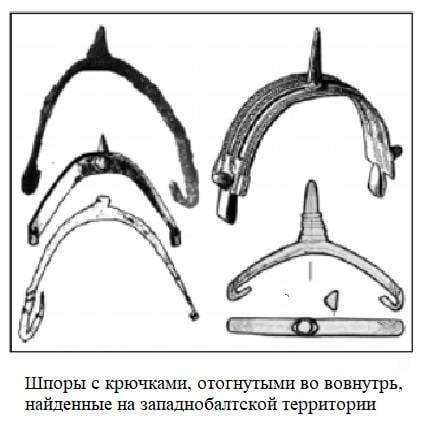
That is, we see that the influence of nomads in this matter is excluded. Which coincides with the data of written sources.
The author of "Strategicon" writes that the Slavs kidnap horses because of ambushes from the soldiers, and John of Ephesus (80s of the XNUMXth century) reports about captured Byzantine herds of horses. This information seems to indicate the beginnings of cavalry.
But if some researchers believe that the purpose of these abductions was to deprive the Byzantine soldiers of horses, others assume that the capture of horses was carried out for their own cavalry (Kuchma V.V., Ivanov S.A.). And therefore the term "army" (Στράτευμα), used by Procopius of Caesarea, should just be attributed not to the army in general, but to the mounted Slavic army (Ivanov S.A.).
In 547 the Slavs raided from the Danube to Epidamnes, which is 900 km in a straight line. Such a trip could only be made on horseback, says S.A. Ivanov.
This is consistent with the military situation even in Italy, where the Roman infantrymen sought to acquire horses.
Without disputing the fact of the possible use of horses by the Slavs when moving over distances, including in raids, we again note that there is a big difference between the cavalry as a combat unit and warriors using horses as a means of delivery.
And during the invasion of Illyria, the Slavs were not particularly threatened, 15 thousand warriors of the strategos (master) of Illyria did not come into contact with them, probably fearing their significant number, which allowed the Slavic warriors to calmly carry out their plans:
Thus, this information has nothing to do with the Slavic cavalry (Στράτευμα). From the above passage it does not at all follow that the raid was carried out by a cavalry army.
The capture of horses, described in a number of sources mentioned above, was dictated by the need for vehicles, at the same time the Byzantines were deprived of them. Moreover, the Roman army already suffered from a lack of horses, as in the situation of 604, when the emperor Mauritius ordered the soldiers to winter in the Slavic lands.
On this score, we have evidence of Simokatta, who described how a Slavic detachment of scouts, these events took place in 594, destroyed the intelligence of the Romans:
And finally, quite eloquent information about one of the military leaders of the Slavs, Ardagast, who, during the alarm, jumped on a bare horse and resolutely dismounted before the battle with the advancing Romans (593).
Having considered this situation, it is difficult to agree with the hypothesis that those few Slavs or Antes, about 300 people (arithma), along with the Huns-federates in Italy, were an army of mounted riflemen. Sources do not confirm this in any way (Kazansky M.M.).
For the period of the VI century. There is no need to talk about any Slavic cavalry, horses were used exclusively for movement during raids and campaigns.
The heads of clans, military leaders, distinguished soldiers, having become acquainted with the decorations of horse equipment, willingly used them, about which we have a few archaeological evidence (Kazansky M.M.).
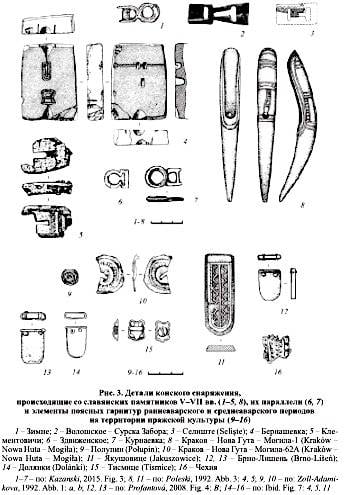
We have several more written testimonies that can be considered as some allusion to the Slavic cavalry.
The first is connected with the campaign of the expeditionary troops of the Stratilatus Priscus in 600, in the very heart of the Avar "state". During which there were several, most likely, horse battles with the Avars. Victory remained with the Romans. Finally, the Avars, having gathered their forces on the Tisse River, tried to take revenge. The troops at the disposal of the Avars consisted of Avars, Bulgars and Gepids, and separately from a large army of Slavs. In this battle, the tributary Slavs, who lived with the Avars in the interfluve of the Tisza and Danube rivers, could fight on foot, and perhaps not.
Close to this is the semi-legendary message that the Slavs - sons born from the Avar rapists, Slavs, could not tolerate such mockery and opposed the Avars. In this case, we are interested in the question of whether they have mastered the skills of horsemen or not.
It seems that such a hypothesis should be dismissed. Firstly, there is no doubt that the Slavs, even in a foot battle, could inflict damage on the Avars, Kagan Bayan claimed that he "suffered severely from them." The victories under the leadership of the first Slavic king Samo were also associated with the fact that the Bulgars riders who rebelled against the Avars became the free or unwitting allies of the Slavs. But the Slavs carried out the battles themselves, nowhere is it said about the allies.
Secondly, no sources later report on the Slavs fighting on horseback in the west during the period under review, and, as we saw above, the Slavs borrow spurs from the west.
And, thirdly, the life of the Slavs-tributaries was carried out within the framework of the clan, and the child born from violence had one way: to be recognized by the clan or not, i.e. perish. It raises great doubts that the ruthless "ethical norms" of the nomads dictated them any obligations in relation to the "slaves", not members of their own kind. Even the Lombard Duchess Romilda, who surrendered the city of Forum Julia (Friul) to the Kagan in 610, was raped and impaled by the Avars.
The collected archaeological evidence speaks of an extremely small influence of nomads on the military affairs of the early Slavs (Kazansky M.M.).
We emphasize that, as in our days, military technologies, sources of raw materials for them were seriously guarded by their owners. We wrote about this in an article on "VO" "The clan and military organization of the early Slavs of the XNUMXth-XNUMXth centuries.".
As for the acquaintance with the specifics of equestrian combat, in particular with archery, nomads taught this to their children and children who fell into slavery in a certain nomad family from an early age. About which we have direct evidence in later sources about the Hungarians. At the same time, of course, the child slave was completely incorporated into the nomadic structure, occupying its own niche in status, but externally not differing from its masters in any way.
Thus, the early Slavs, who were in close contact with the nomads, could not find a professional equestrian army.
Departing a little from the topic, let's say that professional horse troops appear among different Slavic peoples with the emergence of early feudalism, when society is divided into plowing and fighting. These elements can be partially seen in Croatia and Serbia, mostly in Poland and the Czech Republic, which are influenced by their western neighbors, and, of course, in Russia since the end of the XNUMXth century, but not earlier.
Now let us consider the last controversial evidence of the Slavic cavalry at the end of the XNUMXth century.
At the end of the 1th century, after a campaign against the 30st Bulgarian state, Justinian II resettled XNUMX thousand Slavic warriors with their families, led by Prince Nebul, to the territory of Asia Minor, to Bithynia, the Opsikii theme. Vasileus wanted to concentrate a powerful army on the key border for Byzantium.
We do not know about any cavalry units of the Slavs within the state of the Proto-Bulgarians, moreover, even Leo VI the Wise (866-912) divided the tactics and weapons of the Slavs and Bulgarians, emphasizing that the difference between the latter and the Hungarians lies only in the adoption of the Christian faith.
Such power allowed the mad basileus Justinian II to break the world with the Arabs and start hostilities. In 692 the Slavs defeated the Saracen army at Sevastopol in Primorsky. What kind of army was at that moment, foot or horse, we can only guess.
The only evidence of the weapons of the Slavs who moved to Asia Minor is the message about the quiver of Prince Nibul, and this information can be explained in two ways, since the bow and arrows are weapons of both horsemen and infantry.
It seems that the victory of the Slavs over the Arabs, as well as the subsequent bribery of their leader by the Arabs, is due to the fact that the army was really very large. As the Slavs went to the Arabs in 692, Usman b. Al-Walid defeated the Romans in Armenia with 4 thousand forces, as a result of which Armenia passed under the vassalage of the Caliph.
Given the specifics of the Arab front, it is possible that the troops who arrived could have been assigned to the cavalry by the Byzantines, but, most likely, the overwhelming part of the Slavic army remained on foot.
We emphasize once again that the very arrival of such a powerful military masses could significantly change the alignment of forces on the borders with Syria, even if they remained on foot.
The question of the emergence of cavalry (cavalry) among sedentary peoples is not easy and remains largely controversial.
When researchers write about the Slavic cavalry in the VI-VIII centuries, and not about the use of horses as a means of transportation, it seems to me that the moment of complete discrepancy of the Slavic society with a structure that could contain or exhibit a horse army is not taken into account. It was a clan system (a community without primitiveness). Rod fights together, flees together, there is no place for heroism associated with personal death. Responsibility for the condition of the clan is higher than personal heroism, which means that, in relation to the horse, everyone fights either on foot or on horseback (like nomads).
In such a structure, there is no opportunity to acquire the professional skills of a rider, sufficient not for movement, but for battle, only to the detriment of the economic activity of the clan, especially from the ethnic groups of farmers. However, here the Slavs are no exception, and the Goths (tribe) and the Franks, and the Gepids, Eruls, Lombards, and finally, the Saxons - Germanic ethnic groups, standing at different stages of development of pre-state structures - all, for the most part, were foot soldiers:
The emergence of a chiefdom and a squad, standing outside the tribal organization, contributes to the appearance of horsemen among sedentary peoples, but for the early Slavs this is not necessary to talk about.
Let's say about the necessary resources for maintaining the cavalry.
In the "Strategicon" of Mauritius, an entire chapter is devoted to equipping the rider, equipping the horse, providing it: "How to arm an equestrian stratiote and what should be purchased as needed." Equipping one rider with his full support required substantial sums. For the Roman Empire, it cost enormous financial stress.
We observe a similar situation among the nomads, neighbors and rulers of a number of Slavic tribes. Nomads seize profitable places (cities), resettle the Byzantine handicraft population to the territory of the Avar Kaganate, “torture” not only neighboring tribes, but also the Roman Empire with tributes, all this went to support, first of all, the equestrian army-people. 60 thousand horsemen in lamenar armor, according to the message about this event ("they say"), which Menander the Protector wrote down, set off on a campaign against the Sklavins. Let us repeat ourselves, according to Menander's retelling. This huge army of Avars, including servants and auxiliary forces, should have consisted of at least 120 thousand people and the same number of horses.
The maintenance of the army of natural horsemen was expensive, whose entire existence is life on horseback, in contrast to sedentary peoples.
Slavic society at this stage did not have such resources to support the cavalry. Subsistence farming, handicrafts, also within the family, the influence of climatic conditions and external invasions in no way made it possible to allocate resources for excesses.
But in more favorable climatic conditions for life and management, in Greece of the XNUMXth century, the Slavic tribes have more serious weapons and even units, divided by types of weapons, not to mention the masters who are able to forge weapons and create siege machines.
Considering all of the above, we can say that during the period under review, the early Slavs did not have cavalry as a kind of troops.
The data we have allow us to say only that the period of the VI-VIII, and, possibly, the IX century. was a period in the development of the tactics of the early Slavs "from the mob to the ranks."
Sources and literature:
Leo VI the Wise. Leo tactics. The publication was prepared by V.V. Kuchma. SPb., 2012.
Paul the Deacon. History of the Lombards // Monuments of medieval Latin literature of the IV - IX centuries Per. D.N. Rakov M., 1970.
Procopius of Caesarea. War with the Goths / Translation by S.P. Kondratiev. T.I. M., 1996.
Saxon Annalist. Chronicle 741-1139 Translation and comments by I. V. Dyakonov M., 2012.
Codex of ancient written news about the Slavs. T.II. M., 1995.
Strategicon of Mauritius / Translation and commentary by V.V. Kuchma. SPb., 2003.
Theophylact Simokatta. History / Translated by S.P.Kondratyev. M., 1996.
Ivanov Vch. V., Toporov V.N. Research in the field of Slavic antiquities. M., 1974.
Kazansky M.M. Steppe traditions and Slavic weapons and horse equipment in the 254th-2019th centuries / CSIA. Issue XNUMX.M., XNUMX.
Cardini F. The origins of medieval chivalry. M., 1987.
Kirpichnikov A.N. Old Russian weapons. Equipment of a rider and a riding horse in Russia in the XNUMXth-XNUMXth centuries.
Archeology of the USSR. The collection of archaeological sources / Under the general editorship of academician B.A.Rybakov. M., 1973.
A.K. Nefyodkin The tactics of the Slavs in the VI century. (according to the testimony of early Byzantine authors) // Byzantine time book № 87. 2003.
Rybakov B.A. Paganism of the ancient Slavs. M., 1981.
To be continued ...
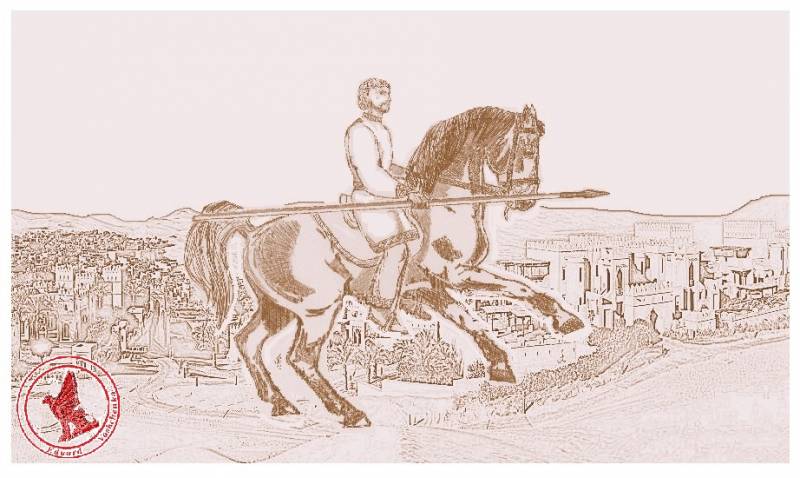
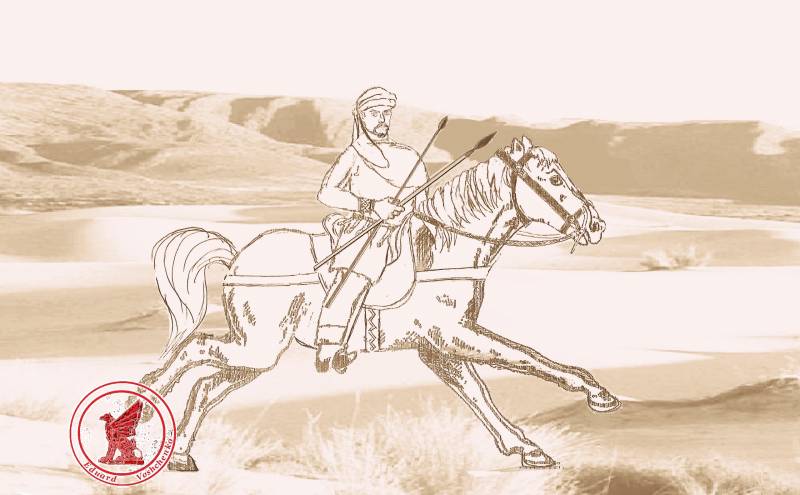
Information